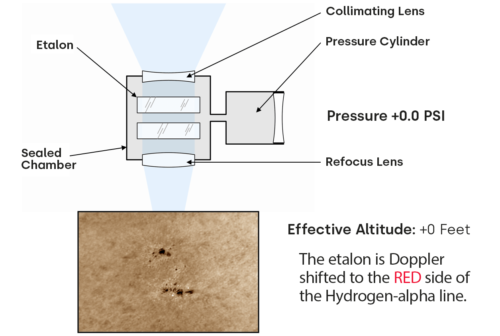
Lunt Solar Systems recently introduced the new Pressure Tune system, or Doppler True Tuning system.
The image above shows the basic outline of this system. The internal etalon is at ambient pressure. The tuning of the etalon is slightly low, putting the Center Wavelength (CWL) at the red wing of the Hydrogen line. This provides a view of less energetic features in the Chromosphere.
How does it work and what does it do?
The system works because the etalons used in the current Lunt designs are air spaced. These air spaced etalons have been typically tuned to the Hydrogen-alpha line via several mechanisms.
The first is the spacing of the air gap between the high reflective surfaces of the ultra flat plates. By changing the spacing, you change the CWL. The distance of this spacing is generally held constant because the refractive index of the medium between the plates (air) is relatively stable at ~1.
The center wavelength can be manipulated from there by slight tilting of the etalon. This changes the angle of the light at the interface of the high reflector/air layer, having the effect of moving the center wavelength toward the blue.
Slight changes in barometric pressure and/or a change in altitude will effect the CWL due to the change in refractive index of the spacer layer.
These changes can be compensated for by additional tilting provided that the etalon is tuned to accommodate those changes.
Taking an etalon that was tuned at 100ft to 10,000ft would certainly not be within that range.
In the past I have manufactured sealed etalon systems for space flight.
These etalon systems were designed to work in a sealed vacuum. As a result they were manufactured as very highly tuned etalons. By placing them under vacuum, the tuning lowered . Tuning was done to ensure that at full vacuum the etalon was on band.
Additional fine tuning from there was done via heat due to the fact that the vacuum could not be adjusted.
Our technology utilizes air pressure and not vacuum.